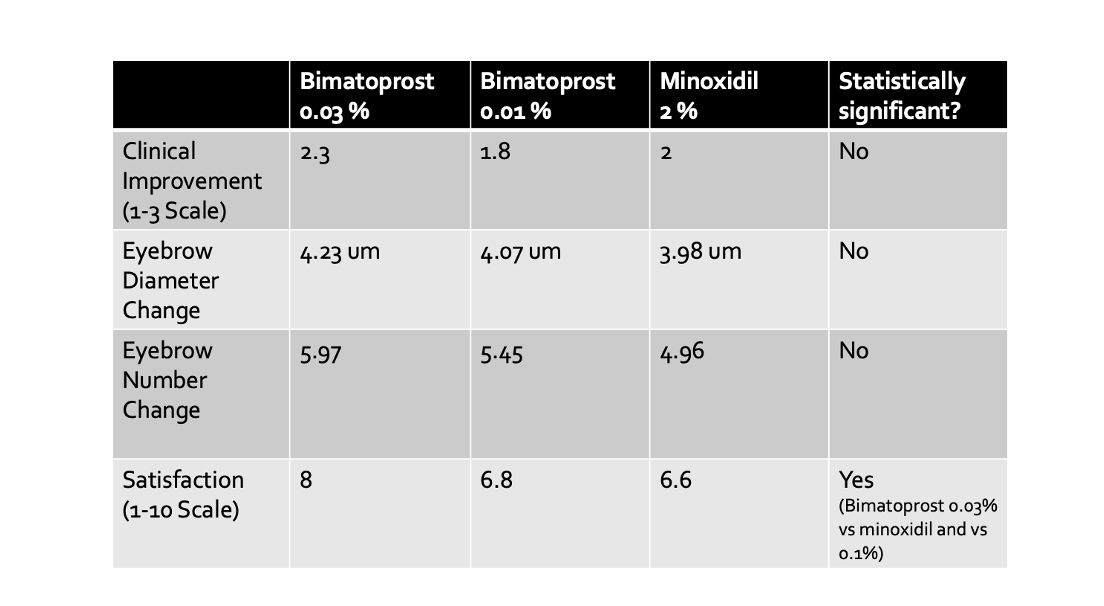Minoxidil 2 % Seems Similar to Bimatoprost 0.03 % for Eyebrow Growth
Randomized Trial Finds Similar Benefits of Minoxidil and Bimatoprost for the Eyebrows
Loss of hair on the eyebrows is common. I’d even estimate that it’s becoming more common in the world …but good studies have not been done. Most people have eyebrow loss to some degree as they age. There has been considerable interest over the years in understanding which treatments are most helpful to get eyebrows growing.
Minoxidil, bimatoprost and latanoprost have received some attention. A 2012 study by Suwanchatchai W, et al published in the Journal of Dermatology suggested that minoxidil and bimatoprost are fairly similar in their effectiveness. This was a small 16 week study that compared results in 27 patients who were applying Latisse to one brow and 3% minoxidil to the other. In the minoxidil group, the eyebrow hair of 51.85% of patients (14 ⁄ 27) was evaluated to be slightly increased. In the bimatoprost group, the eyebrow hair of 59.26% of patients (16 ⁄ 27) was found to be slightly increased. At the end of the 16 week study, patient satisfaction was assessed by use of questionnaires. In the minoxidil group, 44.44% (12 ⁄ 27) reported good improvement. In the bimatoprost group, 40.74% (11 of 27) reported good improvement.
To read more, click on the link below:
Zaky M et 2023
A new study set out to compare the benefits of minoxidil and bimatoprost in the treatment of eyebrow thinning.
This study was a randomized, triple armed single blinded study which compared the efficacy and safety of topical 0.01% and 0.03% bimatoprost versus topical 2% minoxidil applied once daily for 16 weeks.
Patients were randomized into 3 groups. Group a (20 patients) applied topical 0.03% bimatoprost gel once daily onto both eyebrows. Group b (20 patients) applied topical 0.01% bimatoprost gel once daily onto both eyebrows while group c (20 patients) applied topical minoxidil 2% gel once daily onto both eyebrows.
Standard visit standard photographs were taken using digital camera and trichoscopic eyebrow assessment was carried out using trichoscopy. Eyebrow growth was evaluated using the GEBA instrument which is a validated 4-point scale used to grade fullness of the eyebrows (1=very sparse, 2=sparse, 3=full, and 4=very full)
Results
In total there were 60 female patients. The mean age for bimatoprost 0.03% group was 34.40 while bimatoprost 0.01% group mean age 36.10 and minoxidil 2% group mean age was 32.30. There was no significant difference between the studied groups regarding age and sex.
Eyebrow density was similar in all three groups before stating treatment . After 4 months of treatment, the proportion of patients with at least a 1-grade improvement in GEBA scale was 100% in the 0.03% bimatoprost group compared to 80% of patients in both of the bimatoprost 0.01% and minoxidil 2% groups. A significant improvement in GEBA score was reported in all the three groups after treatment (P≤0.001); however, there was no statistically significant difference between the three groups.
After 16 weeks of treatment, hair diameter improved in all three groups. Eyebrow hair number also improved in all three groups. However, there was no statistically significant difference between the three groups.
Patient satisfaction was the one area where there was a difference. At the end of the study, 100% of patients in the three groups reported improvement in their eyebrow appearance on the self-evaluation with 7-point rating scale. Moreover, using a satisfaction rating scale ranging from 1 to 10; patients in the Bimatoprost 0.03 % group had highest satisfaction.
Patients in the bimatoprost 0.03 % group demonstrated a significantly higher satisfaction score of 8.0 ± 0.65) vs bimatoprost 0.01% which was 6.80±0.62 or minoxidil 2% which was 6.60 ± 0.50) respectively (p1 ≤ 0.01; p2 ≤ 0.01)
All three groups had good safety and there were no serious events.
Conclusion
All in all this was an interesting study. The main findings are similar to the 2012 study – namely that minoxidil and bimatoprost are fairly similarly in their ability to grow eyebrows.
It would be interesting to determine if 5 % minoxidil would be more effective and if the combination of minoxidil and Bimatoprost together would be even more effective than either one alone.
It is encouraging that side effects were very low and these medications were so well tolerated. Cost is one thing that was note studied and it’s likely that 2 % minoxidil is far less expensive than bimatoprost when used on the eyebrows. If the two are similarly effective and similarly safe, it could be that cost favors use of minoxidil slightly over use of bimatoprost. (SEE SAFE PRINCIPLE)
One must remember that this was a study of females and a study taken to 16 weeks. Whether men respond similarly can not be concluded from this study. In addition, one can not conclude that similar results would be found if the study was taken out to 52 weeks or 520 weeks. This is a study which stops at 16 weeks.
REFERENCE
Zaky M et al.Comparative study of the efficacy and safety of topical minoxidil 2% versus topical bimatoprost 0.01% versus topical bimatoprost 0.03% in treatment of eyebrow hypotrichosis: a randomized controlled trial./Arch Dermatol Res. 2023 Jul 30.
Suwanchatchai W, et al. Efficacy and safety of bimatoprost 0.03% versus minoxidil 3% in enhancement of eyebrows: a randomized, double-blind, split-face comparative study. J Dermatol. 2012.
This article was written by Dr. Jeff Donovan, a Canadian and US board certified dermatologist specializing exclusively in hair loss.



